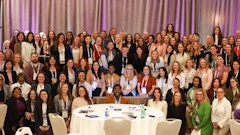
The manufacturing industry has a talent problem. By 2033, 2.8 million workers across the country are projected to retire. At the same time, another 1 million roles will be created through industry advancements and regulations. In another industry, the prospect of 4 million open roles may invigorate leaders and candidates alike, creating a tremendous opportunity for a new wave of growth and innovation.
But in manufacturing, where nearly half (48%) of businesses cite attracting and retaining talent as a top challenge, such a vacancy looms large and even threatens business continuity.
This might be surprising, given all that the manufacturing industry has to offer. It’s increasingly characterized by advanced technology like automation, AI, and robotics. It’s the source of every item we own: our smartphones, our favorite clothes, our cars. It’s the lifeblood of the global economy. It drives nations forward. It saves lives. So why isn’t young talent getting on board? Where’s the disconnect?
It’s all about perception. The manufacturing industry needs to fix its image, or else organizations will end up in freefall.
Manufacturing’s pervasive perception problem
Despite a growing openness to trades, many young workers still view manufacturing as outdated, dangerous, inflexible, low-paying, and devoid of innovation. By and large, the industry’s public image is one of sweatshops and dank factories; people imagine dismal assembly lines driven by human workers manually pulling the same lever ad nauseam until they punch out for the day.
Many people don’t think of manufacturing as a dynamic career whose pathways will enable them to hone new skills, wield advanced technology, and make a lasting difference in their community. This perception is not only misinformed but dangerous for the industry itself.
To bring young talent into the fold, manufacturers will need to correct public perception and show potential candidates that the industry can offer what they’re looking for.
Gen Zers take their careers seriously
Gen Z often gets a bad rap; like most young generations, they get stereotyped as being lazy and unwilling to put in the effort to make something work. But Gen Z workers are looking for the same kinds of career benefits that other generations have for centuries: fair compensation, respectful workplaces, and caring leaders.
They do have unique generational attributes, though—preferences that leaders shouldn’t ignore. Broadly, Gen Z workers are looking for:
· Clear growth paths: Nobody wants to work at a dead-end job—especially younger generations, who have most of their lives still ahead of them. Not only does Gen Z highly value clear growth paths and hands-on mentoring, but they are likely to leave jobs without these opportunities. In fact, it’s a Top 3 reason for attrition for 41% of Gen Z.
· Meaningful work: Gen Z also wants to know that their work makes a difference in others’ lives. For 37%, finding meaningful work is a top priority during job searches. Conversely, 35% of Gen Z will walk away if they don’t feel their work matters.
Despite generalizations to the contrary, Gen Z is in it for the long haul. They want to find careers where they can grow, learn, and make a difference in their communities.
Closing the generational gap
If manufacturers want to attract and retain young talent pools, they’ll need to (A) make sure their workplace has what Gen Z is looking for and (B) make sure people know about it. Making the necessary changes isn’t a purely cosmetic fix; it’s existential—it will make businesses stronger, more resilient, and more successful.
First, manufacturers need to embrace advanced technology and digital transformation. AI, automation, and connected systems bring data-driven precision to manufacturing facilities, directly facilitating continuous improvement, traceability, quality improvements, and greener operations.
Not only does the integration of advanced tech open up new, high-tech job opportunities, but it also removes humans from the lower-level, dangerous, and “dirty” jobs that don’t appeal to younger generations. For example, a robot can perform industrial welding jobs while a trained technician monitors its performance. These tech-adjacent roles appeal to younger generations like Gen Z, who are increasingly likely to have gleaned advanced tech skills through their higher education. If trained and onboarded effectively, they can be an asset to manufacturers from day 1.
Employee training and up- and reskilling go hand in hand with advanced technology. The industry is moving inexorably forward; effective leaders are those who guide their teams toward the future by giving them opportunities to rise to the occasion. This means on-the-job training, continuing education, and hands-on mentorship to help support teams through inevitable hiccups.
By inviting teams to be a part of the next, high-tech chapter of the manufacturing industry, leaders add value to workers’ roles, rather than alienating them in the face of inevitable change. Nobody wants to feel like they’re stagnating in their roles or being left behind. Continuous learning opportunities and defined career pathways give employees a sense of purpose, accomplishment, and pride in what they do.
Talking the talk
Once leaders have made these changes—or begun genuine efforts toward them—it’s time to talk about it. Spread the word by engaging with local communities; offer internship or mentorship positions to students; highlight the beauty and wonder and innovation that the industry brings. Don’t just be proud of your work; live that pride and share it with others. If done right, the manufacturing industry will come to be known as a launchpad for a new class of tech-savvy, purpose-driven workers.
Meeting younger generations where they’re at and helping change their preconceived notions about manufacturing isn’t as hard as it might seem—it starts one leader, one business, one challenge at a time.
















![Pros To Know 2026 [color]](https://img.sdcexec.com/mindful/acbm/workspaces/default/uploads/2025/08/prostoknow-2026-color.mduFvhpgMk.png?ar=16%3A9&auto=format%2Ccompress&bg=fff&fill-color=fff&fit=fill&h=135&q=70&w=240)
